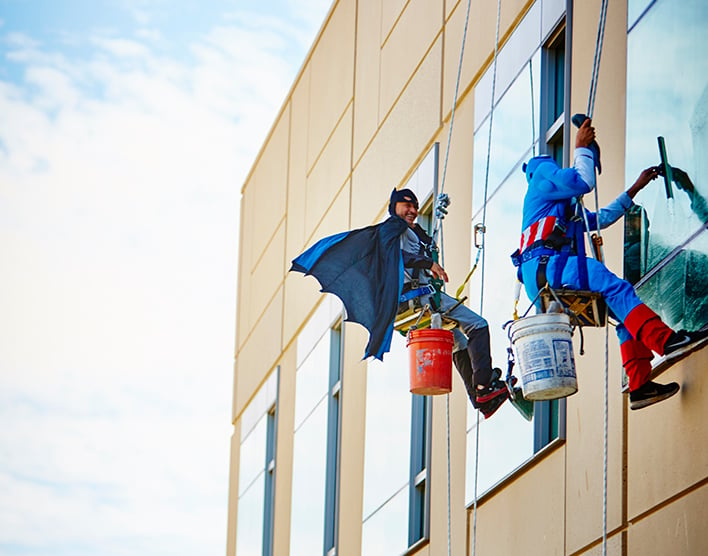Staff superheroes
It’s a bird. It’s a plane. It’s a window washer! Dressed as a superhero to clean and brighten your day.


In order to understand constipation, one must first understand normal bowel function. Stool is formed as a result of digestion of the food eaten. The digestive process begins when anything is taken into the mouth. Saliva starts to breakdown the food in the mouth.
As it passes down the esophagus and into the stomach, further breakdown occurs. It then passes into the small intestines in a semi-liquid form. The body begins to absorb nutrients through the small intestine wall, leaving behind waste products. This liquid is moved through the small intestine by peristalsis.
Peristalsis is a reflex caused by a distention of the intestine from the liquid food, followed by a constriction in the same area of distention. This propels the food forward. As peristalsis moves the liquid toward the large intestine all of the nutrients are absorbed. The liquid entering the large intestine is liquid waste.
The large intestine or colon is in the shape of an upside down "U." The motility slows down allowing for water to be reabsorbed and soft stool to be formed. The colon deposits the stool into the rectum. The rectum can be considered a "holding area" very similar to the bladder's role for urine. It is empty and fills with stool prior to having a bowel movement.
The internal anal sphincter is at the end of the rectum. It is an involuntarily controlled muscle that automatically opens when the rectum is full of stool. This allows the stool to move into the anal canal. This passage also activates a signal that goes to the spinal cord and up to the brain alerting the individual that a bowel movement is imminent. The external anal sphincter is a voluntarily controlled muscle at the other end of the anal canal. When the brain receives the impending bowel movement signal, a message is sent to the external anal sphincter to contract. It remains closed until the individual signals it is safe to relax. The stool passes out of the body to the toilet.
Most people find they have a routine time for a bowel movement. For many it is in the morning after a hot beverage, for some it is in the evening after a warm bath or shower. Some people also will note that a bowel movement does not happen everyday but every other day. The importance is knowing that there is a pattern to the time of bowel movements.
Regularity can be affected by: foods, medications (ditropan), activity, emotions, a change in routine (vacations) or location of the bathroom. Knowing the pattern can prevent any changes in regularity.
Constipation can present in many different ways including:
The most common cause of constipation in the otherwise healthy child is "withholding".
Children will withhold stool for many different reasons including, but not limited to:
When the child withholds stool the rectum expands to accommodate the increasing amount of stool. As the stool remains in the rectum/bowel, the stool bolus will not only increase in size, but it will also become hard. Stool becomes hard because the body reabsorbs water from the stool as long as stool remains in the bowel. So, the longer the stool remains in the bowel, the more water will be absorbed by the body and the harder the stool will get. As the rectum continues to expand, the child's normal urge to defecate gradually vanishes. As the cycle is repeated, greater amounts of stool are built up in the rectum and bowel. As a result of this chronic retention, the ability of the bowel to move stool contents is diminished (decreased motility). Subsequently, rectal elasticity and sensation further decrease. In other words, children who have chronic constipation lose the ability to sense when the rectum is full and overtime lose the ability to evacuate the bowel completely. Another problem that may occur, exacerbating this process, is when the child finally does pass stool, the defecation may be painful due to the large/hard stool. The painful defecation may subsequently cause the child to further withhold stool due to fear of another painful defecation.
As the cycle progresses, some children will begin to have stool incontinence (otherwise known as soiling or encopresis). Stool incontinence occurs:
It is important to note that no organic etiology is found in 90% to 95% of children with constipation. In addition, what causes constipation in adults does not necessarily cause constipation in children. The following table describes some of the differences between constipation in children and constipation in adults.
| Differences Between Children and Adults |
||
| Children |
Adults |
|
| Prevalence |
Mostly boys |
Mostly woman |
| Social | Equal |
Non-white, low income Adolescent/young adult |
| Transit Time | 16 hours |
30-48 hours after puberty |
| Behavior |
Withholding | Straining |
| Incontinence | Common |
Uncommon |
| Disease | Rare |
Common |
| Medications |
Rare |
Common |
| Sedentary life |
Rare | Yes |
| Fiber diet | Rarely helpful |
Helpful |
| Biofeedback |
Unclear benefit |
Helpful with pelvic floor dyssynergia |
Bladder problems can also cause constipation. Children use the same muscles to withhold urine as they do for withholding stool. Certain causes of childhood incontinence such as classic voiding dysfunction or an uninhibited (hyper or overactive) bladder (see separate handout) can cause children to contract their pelvic floor muscles in an attempt to remain continent of urine. This increase in activity can cause these children to retain stool as well, leading to the previously mentioned dysfunctional cycle. In other words, if a child is chronically contracting the pelvic floor to retain urine then they will not only retain stool but they will have difficulty relaxing the pelvic floor at the time of a bowel movement.
Constipation can be the cause of urinary tract infections and childhood urinary incontinence. As mentioned earlier, some causes of childhood incontinence can also cause constipation. In addition, some medications used in urology for the treatment of incontinence can also cause constipation.
Studies have shown the following relationships between constipation and urologic conditions:
Please note, while often brought up as a concern, there is actually no evidence that constipation causes or contributes to colon cancer.
It is very difficult to assess constipation in children. Most parents do not know their children's bowel habits, and the children themselves are rarely able to give a good bowel history.
Based on the history and physical exam, your urology practitioner may simply just assume your child is constipated (based on symptoms and physical exam) and treat your child for constipation. If the history and physical exam are too difficult to illicit, or "unknown," which is not uncommon, then the urology practitioner may want to obtain an x-ray to thoroughly assess for constipation. The x-ray is useful as it allows the doctor/nurse practitioner to assess exactly how constipated a child is and then tailor treatment. However, the x-ray does expose the children to a bit of radiation so, if there is a high suspicion of constipation it may be better to just go ahead and treat the child without the x-ray.
Our goal is to re-establish normal bowel movements and relieve constipation, thereby decreasing urinary tract infections, urinary incontinence and, when necessary, stool incontinence.
Normal bowel movements:
Note: treatment may take several months. Successful treatment is dependent upon having patience and not stopping the therapy too early.
Our recommended treatment will be in two phases:
There are many different types of medicines used in the treatment of constipation. All have their own risks and benefits.
The 4 primary categories are:
In our practice, for the treatment of chronic constipation, we use primarily the lubricants and the osmotic laxatives. This is because the lubricants and osmotic laxatives are safe and effective and they are the least likely to be absorbed into the body (with the exception of the magnesium supplements which we only use for the clean out phase).
The stimulants are best used only for the short term; for example, cleaning the bowel prior to a procedure. Some believe that chronic use of stimulants will take away the body's normal reflex to have a bowel movement (in other words stimulants can become addictive).
The stool softeners, such as colace, are best used to treat constipation in patients who need to avoid straining (for example after surgery). The primary side effects of all stool medications include; soiling, gas, nausea, vomiting, abdominal pain and diarrhea.
Initial Clean Out Phase
The clean out process is carried out over the first three days to a week. It is essential to get out all the stool initially. The success of the entire treatment is dependent on a successful initial clean out. Stool continence cannot be achieved without this initial process. The clean out phase can only be done successfully with medication.
The following medications may be used:
Maintenance Phase
Now that the bowel has been "cleaned out" we must keep the bowel cleaned out. We do this in the maintenance phase. This phase may last as long as 6 months. This process allows for maintenance of regular bowel movements and keeping the bowel empty. There are 3 parts to the maintenance phase; medication, diet/ fiber, and the daily sit.
Medications:
Fiber by Diet:
Fiber by Supplement
There are many different types of supplemental fiber. For younger children, the powder form might be the best choice as it can easily be mixed in liquid. For older ones who can swallow pills, the tablet or capsule form is probably easiest. For kids somewhere in between, wafers might be the best choice. (In our practice, we call the fiber wafers "Scooby Snacks.")
The fluid/fiber ratio is important! Not enough fluid with the fiber can make constipation worse. If using the wafers or tablets, it's best to have the child drink the liquid first and then give them the fiber. (That way if they don't drink all the liquid, you can give them less fiber.) Of the powders, Benefiber seems to dissolve the best in water or juice, which makes it more palatable to small children. Benefiber is available over the counter at any local pharmacy or may be ordered directly through from the company that produces it.
Daily Sit
Biofeedback has become quite popular in the treatment of stool and urinary incontinence; however, at this point in time there is only limited evidence showing a short-term benefit. It appears that there is not long-term benefit from adding biofeedback training to conventional treatment of constipation in children.
UCSF Benioff Children's Hospitals medical specialists have reviewed this information. It is for educational purposes only and is not intended to replace the advice of your child's doctor or other health care provider. We encourage you to discuss any questions or concerns you may have with your child's provider.

Best in Northern California for urology

Ranked among the nation's best in 11 specialties
Staff superheroes
